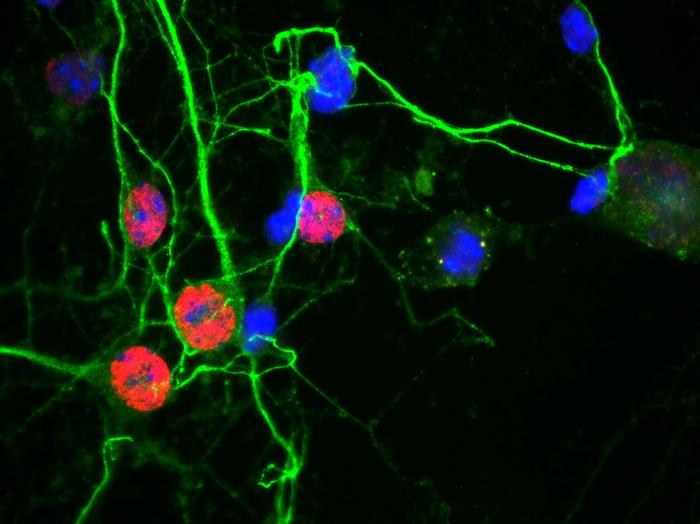Amyotrophic lateral sclerosis, ALS for short, is a mysterious neurodegenerative disease that is almost always fatal. A consortium of researchers led by the Technical University of Munich (TUM) has systematically investigated the underlying molecular mechanisms of ALS. Among other things, the team discovered that ALS can be divided into subtypes. Depending on the subtype, different drugs could be effective. There are also clear differences in the molecular processes when comparing men and women. Furthermore, the researchers identified a promising target for new drugs against ALS.

Credit: Mojan Parvaz / TUM
Amyotrophic lateral sclerosis, ALS for short, is a mysterious neurodegenerative disease that is almost always fatal. A consortium of researchers led by the Technical University of Munich (TUM) has systematically investigated the underlying molecular mechanisms of ALS. Among other things, the team discovered that ALS can be divided into subtypes. Depending on the subtype, different drugs could be effective. There are also clear differences in the molecular processes when comparing men and women. Furthermore, the researchers identified a promising target for new drugs against ALS.
The molecular processes in the body that cause ALS patients to increasingly lose control of motor functions are still poorly understood. Previous studies have been limited to individual aspects of the underlying molecular processes. A consortium led by Prof. Paul Lingor, a neurologist at TUM, has investigated ALS using a so-called “multi-omics” approach. The researchers mapped both coding and non-coding RNA molecules and the entirety of the proteins.
Four subtypes
A key finding of the study is that ALS can be roughly divided into four subtypes. “You can’t distinguish between these variants based on the clinical symptoms,” says Paul Lingor, who, together with other researchers is part of the SyNergy Cluster of Excellence investigating neurodegenerative diseases. “However, very different things happen at the molecular level. This means that an active substance that is ineffective in one ALS subtype may well be helpful in another. Previous clinical studies could only look at the effects across all patients and may not have identified substances effective for an individual subtype.”
While in one common subtype genes associated with inflammatory processes and immune responses were affected, in another there were mainly disturbances in the transcription of DNA into RNA molecules. In two others, different signs of oxidative stress were found in the cells. The researchers assume that the ALS subtype may change over the course of the disease.
Promising drug identified
Men develop ALS around 1.2 times more frequently than women. The breakdown of the molecular processes also revealed clear differences between the sexes. While the four subtypes appear to occur equally frequently in both sexes, the researchers found a significantly larger number of altered gene products in men. From the researchers’ point of view, this could mean that men and women will have to be treated differently in future.
Through the multi-omics analysis, the researchers also identified a signaling pathway that could be a particularly suitable target for new drugs against ALS. “This signaling pathway, MAPK, is well described in neurobiology and plays a role in various, although by no means all, processes in ALS,” says Prof. Stefan Bonn, co-last author of the study and Director of the Institute for Medical Systems Biology at the University Medical Center Hamburg Eppendorf (UKE). From the researchers’ point of view, it would therefore be promising to repurpose an approved cancer drug that acts on MAPK for ALS.
Basis for future studies
The study is based on tissue samples from deceased ALS patients and additional investigations using mouse models of the disease. “An important next step is to find a way to determine the ALS subtype of patients while they are still alive – we are currently working on this,” says Paul Lingor. “We believe that our study made an important contribution to the search for causes and therapies for ALS. Our findings have brought us a good deal closer to a more personalized and, therefore, more effective therapy.”
Publication:
Caldi Gomes, L., Hänzelmann, S., Hausmann, F. et al. “Multiomic ALS signatures highlight subclusters and sex differences suggesting the MAPK pathway as therapeutic target”. Nat Commun 15, 4893 (2024). DOI:10.1038/s41467-024-49196-y
Further information:
- Prof. Paul Lingor is an Associate Investigator in the SyNergy Cluster of Excellence.
- Clusters of Excellence at TUM:
- Every year the International Alliance of ALS/MND Associations celebrates 21 June as the global day of recognition of ALS/MND:
Additional Material for Media Outlets:
Subject matter expert:
Prof. Dr. Paul Lingor
Technical University of Munich
Klinikum rechts der Isar der TUM
Department of Neurology
Tel. +49 89 4140 8257
paul.lingor@tum.de
https://neurologie.mri.tum.de/
TUM Corporate Communications Center contact:
Paul Hellmich
Media Relations
Tel. +49 (0) 89 289 22731
presse@tum.de
www.tum.de
Journal
Nature Communications
Method of Research
Data/statistical analysis
Subject of Research
Human tissue samples
Article Title
Multiomic ALS signatures highlight subclusters and sex differences suggesting the MAPK pathway as therapeutic target
Article Publication Date
7-Jun-2024
COI Statement
The authors declare no competing interests.



